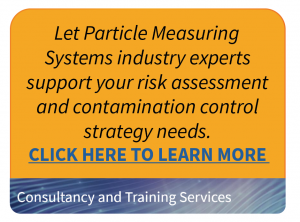Where to Monitor for Particle Contamination?
The next concern after validating your particle monitoring process for powder filling is Where to monitor for particle contamination? As previously discussed, EU GMP Annex 1 states that particle monitoring should be routine and based on risk analysis. Particle Measuring Systems (PMS) uses an approach that is based on extensive process flow and environmental monitoring experience. Regulatory guidance supports this approach and along with an issued system rationale document. It uses data attained during a room classification exercise to justify selection parameters.
Cleanroom classification essentially proves that the room meets its specification for both cleanliness and uniformity. Much of the ISO 14644-1 standard supports the following:
- The cleanroom meets a particle count concentration requirement.
- The cleanroom’s particle concentration is evenly distributed.
If a cleanroom is not uniform and has areas considered worse-off than others, the room will not meet uniformity requirements. In addition, it won’t comply with the 96% upper control limit (UCL). There are steps to make a room uniform and the PMS Advisory Team experts can offer guidance for your specific circumstances.
Who Can Perform a Risk Analysis?
Suitable locations for the sample within the RABS or background area can be determined by applying a grid similar to the grid in the Particle Measuring Systems application note Choosing the Most Suitable Particle Sample Point Locations. The shape of the grid is based on the process to be qualified. Quality assurance teams may work together with third-party experts to optimize their sampling.
Learn more… Get the full paper here.


